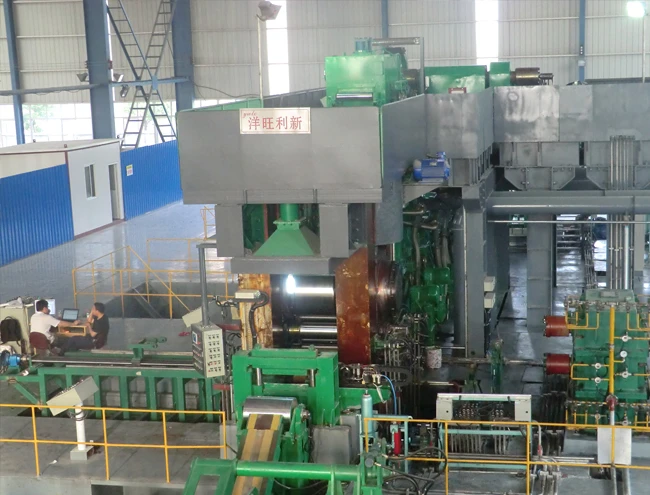
Cladding Rolling Mill-Beijing Yang Wang Li Xin Sci&Tech|Cold Rolling Cladding,Energy Conservation
As industries increasingly demand advanced materials with superior performance and environmental compliance, the Cladding Rolling Mill developed by Shijiazhuang Yangwang Electromechanical Technology Co., Ltd. (YWLX) stands out as a transformative solution. This cutting-edge technology addresses critical challenges in traditional metal cladding processes, offering a sustainable, cost-effective, and high-efficiency alternative. By leveraging cold rolling techniques, YWLX has redefined the standards for surface quality, energy conservation, and production scalability in the metalworking sector.

Technical Features of the Cladding Rolling Mill
The Cladding Rolling Mill is engineered with a focus on precision and innovation, delivering exceptional results through its advanced cold rolling process. One of its standout features is the good surface quality, achieved by eliminating the need for acid pickling treatment. Unlike conventional methods that leave oxides on the metal surface, YWLX's technology ensures a clean, oxide-free finish, reducing post-processing steps and enhancing material integrity.
Another critical technical advantage is its energy conservation and environmental protection capabilities. By eliminating the need for reheating before rolling and avoiding acid pickling, the process significantly reduces energy consumption and minimizes harmful emissions. This aligns with global efforts to adopt greener manufacturing practices, making it a preferred choice for industries committed to sustainability.
The simplicity of the rolling process further underscores its efficiency. The technology involves only three main phases: surface treatment before rolling, bonding rolling, and annealing treatment. This streamlined approach results in a high yield rate (above 90%), lower production costs, and reduced capital investment. Such efficiency is particularly valuable in sectors where cost-effectiveness and rapid scalability are paramount.

Advantages Over Traditional Cladding Methods
Historically, industries relied on exploding cladding and hot roll bonding cladding technologies, which often faced limitations such as low surface quality, high energy consumption, and significant investment requirements. YWLX's cold rolling cladding technology addresses these challenges by offering a more refined and sustainable alternative.
For instance, the cold rolling cladding process eliminates the need for reheating, which not only conserves energy but also prevents thermal degradation of the metal. Additionally, the absence of acid pickling reduces chemical waste, further enhancing environmental compliance. These benefits make YWLX's technology a game-changer for industries like electronics, automotive, and chemical manufacturing, where material quality and sustainability are non-negotiable.
The versatility of the Cladding Rolling Mill is another major advantage. It supports the bonding of various metal combinations, including copper-steel, aluminum-steel, copper-aluminum, aluminum-stainless steel, and stainless steel-steel. This capability enables the production of bimetallic or triple-metallic strips in a single production line, catering to diverse industrial applications. For example, copper-steel cladding is widely used in heat exchangers, while aluminum-stainless steel combinations are popular in architectural and automotive sectors.
Technical Specifications and Capabilities
| Feature | Specification |
|---|---|
| Maximum Strip Width | 1000 mm |
| Minimum Thickness | 0.2 mm |
| Supported Metal Combinations | Copper-Steel, Aluminum-Steel, Copper-Aluminum, Aluminum-Stainless Steel, Stainless Steel-Steel |
| Yield Rate | Over 90% |
| Energy Consumption | Reduced by up to 30% compared to traditional methods |
| Environmental Compliance | Zero acid pickling, minimal emissions |
Applications Across Industries
The Cladding Rolling Mill's adaptability makes it suitable for a wide range of industries. In the electronic industry, it is used to produce high-conductivity copper-steel strips for heat sinks and circuit boards. The chemical industry benefits from corrosion-resistant aluminum-stainless steel cladding in storage tanks and pipelines. Meanwhile, the automotive sector utilizes lightweight aluminum-steel combinations for body panels, improving fuel efficiency without compromising strength.
In the construction and decorative materials industry, the technology enables the production of aesthetically pleasing and durable cladding sheets. For example, stainless steel-steel combinations are used in high-rise buildings for their durability and sleek appearance. Additionally, the clad pipe welding applications benefit from the precise bonding of dissimilar metals, ensuring structural integrity in complex piping systems.
About Shijiazhuang Yangwang Electromechanical Technology Co., Ltd.
Founded as a leader in metalworking innovation, Shijiazhuang Yangwang Electromechanical Technology Co., Ltd. has consistently pushed the boundaries of cladding technology. The company's commitment to research and development has led to the creation of the cold rolling cladding technology, which integrates the latest global advancements in metallurgy and process engineering. YWLX's expertise in this field is further evidenced by its successful implementation of copper-steel and aluminum-steel cladding in actual production, demonstrating its ability to meet stringent industry standards.
YWLX's state-of-the-art equipment and proprietary processes ensure that its products meet the highest quality benchmarks. The company's focus on sustainability and efficiency aligns with global trends, positioning it as a trusted partner for industries seeking to reduce their environmental footprint while maintaining operational excellence.
Conclusion
The Cladding Rolling Mill by YWLX represents a significant leap forward in metal cladding technology. By combining cold rolling techniques with a streamlined production process, it offers unparalleled surface quality, energy efficiency, and cost-effectiveness. As industries continue to prioritize sustainability and innovation, YWLX's solutions are poised to play a pivotal role in shaping the future of metalworking.
For more information about YWLX's products and services, visit the company's official website.
References
According to the National Institute of Standards and Technology (NIST), "measurements and research fuel innovation and improve the quality of life for all Americans." Source: NIST
-
YWLX’s 1450mm Six-Hi Reversing Mill Goes Live in BangladeshNewsNov.24,2025
-
Adjusting Roll Gap in 6Hi Reversing Cold Rolling Mill for Thin StripNewsNov.13,2025
-
Quality Control Standards for Automatic Gauge Control in Strip RollingNewsNov.13,2025
-
Effect of Skin Pass Rolling on Metal DuctilityNewsNov.13,2025
-
Key Components of a Modern TempermillNewsNov.13,2025
-
Common Wear Patterns of Work Roll in Tandem Cold Mill OperationsNewsNov.13,2025
-
Revolutionary Skin Pass Rolling Technology for Enhanced Steel QualityNewsNov.04,2025










